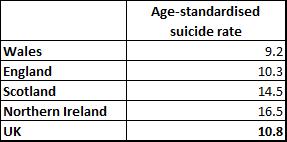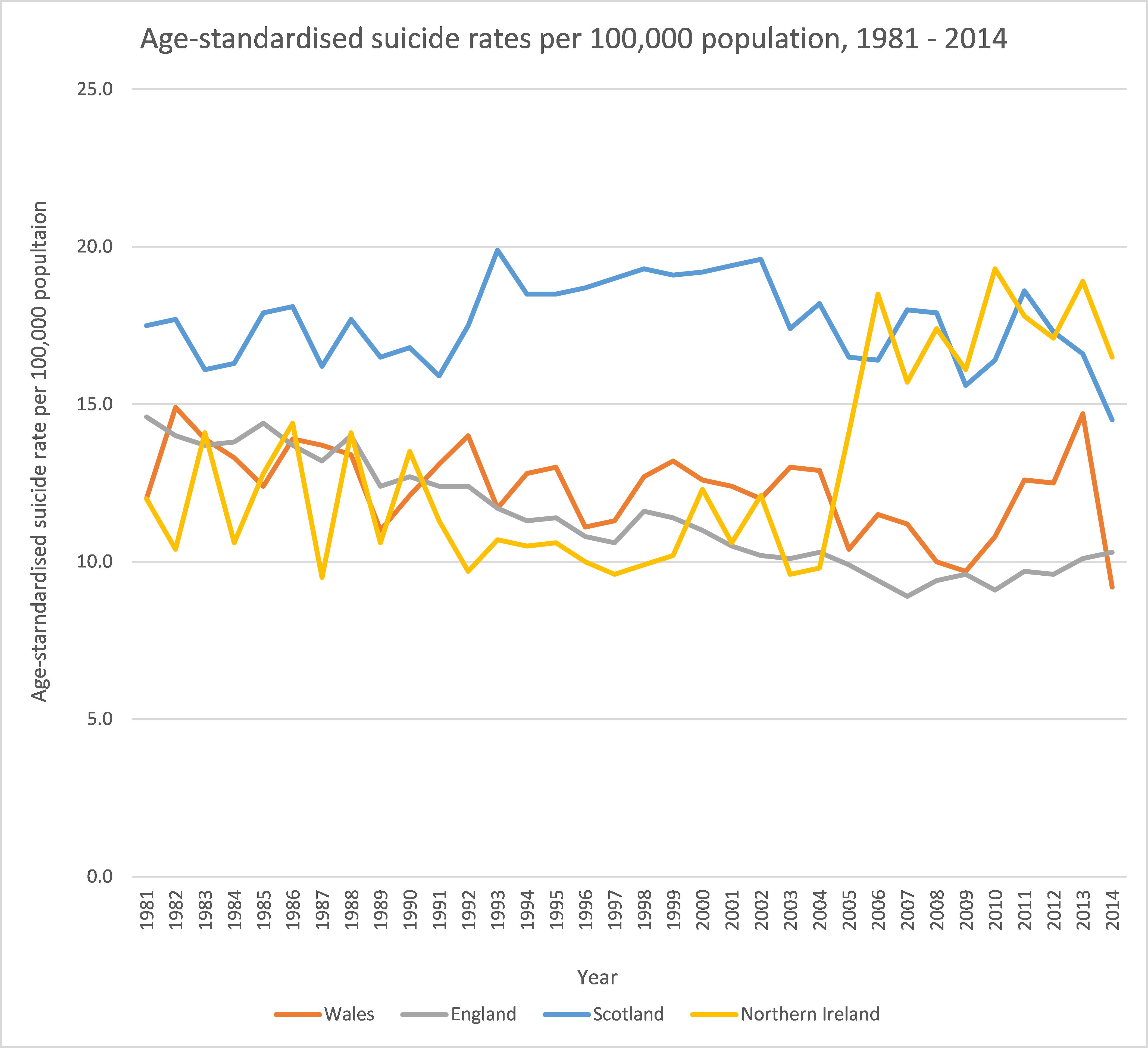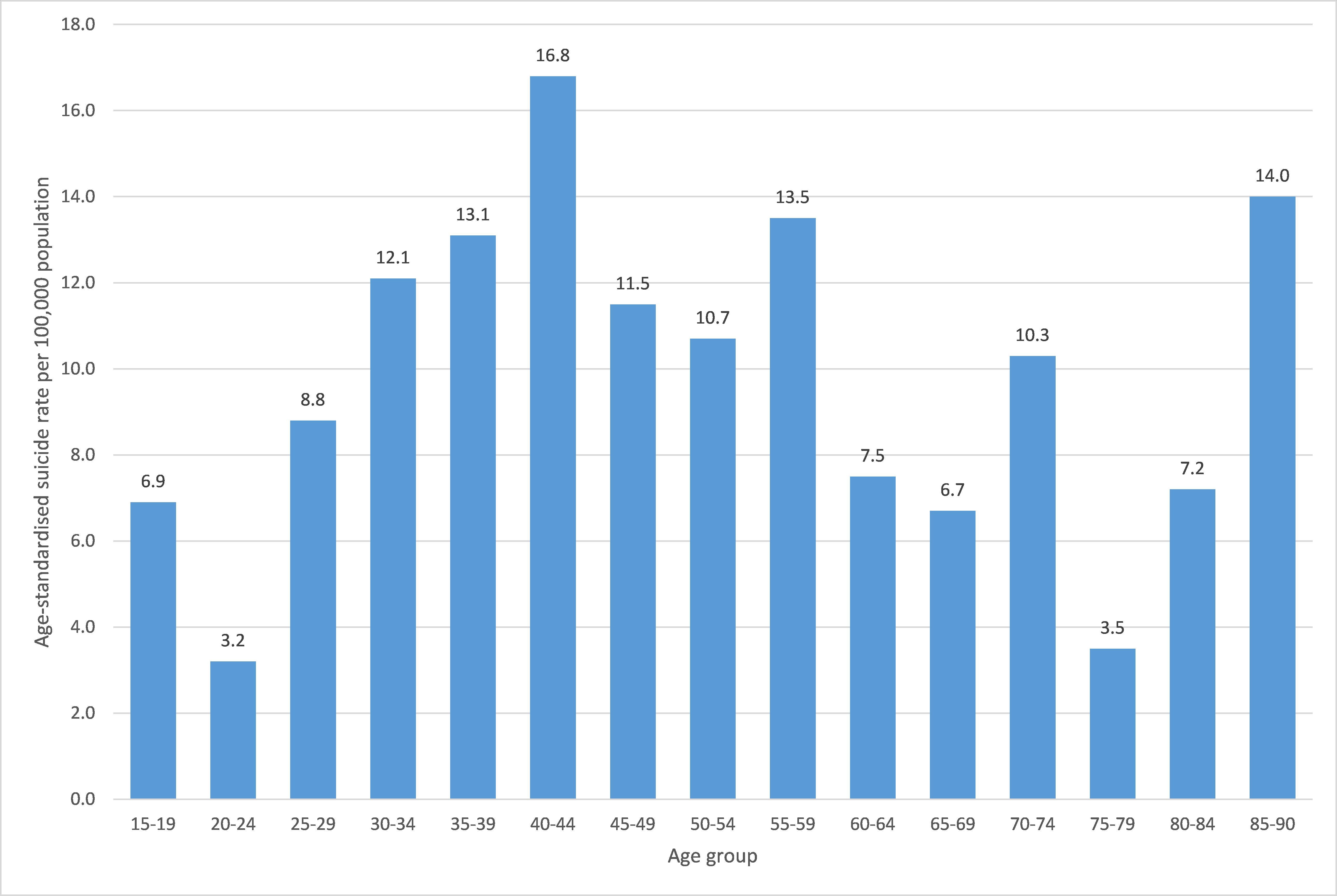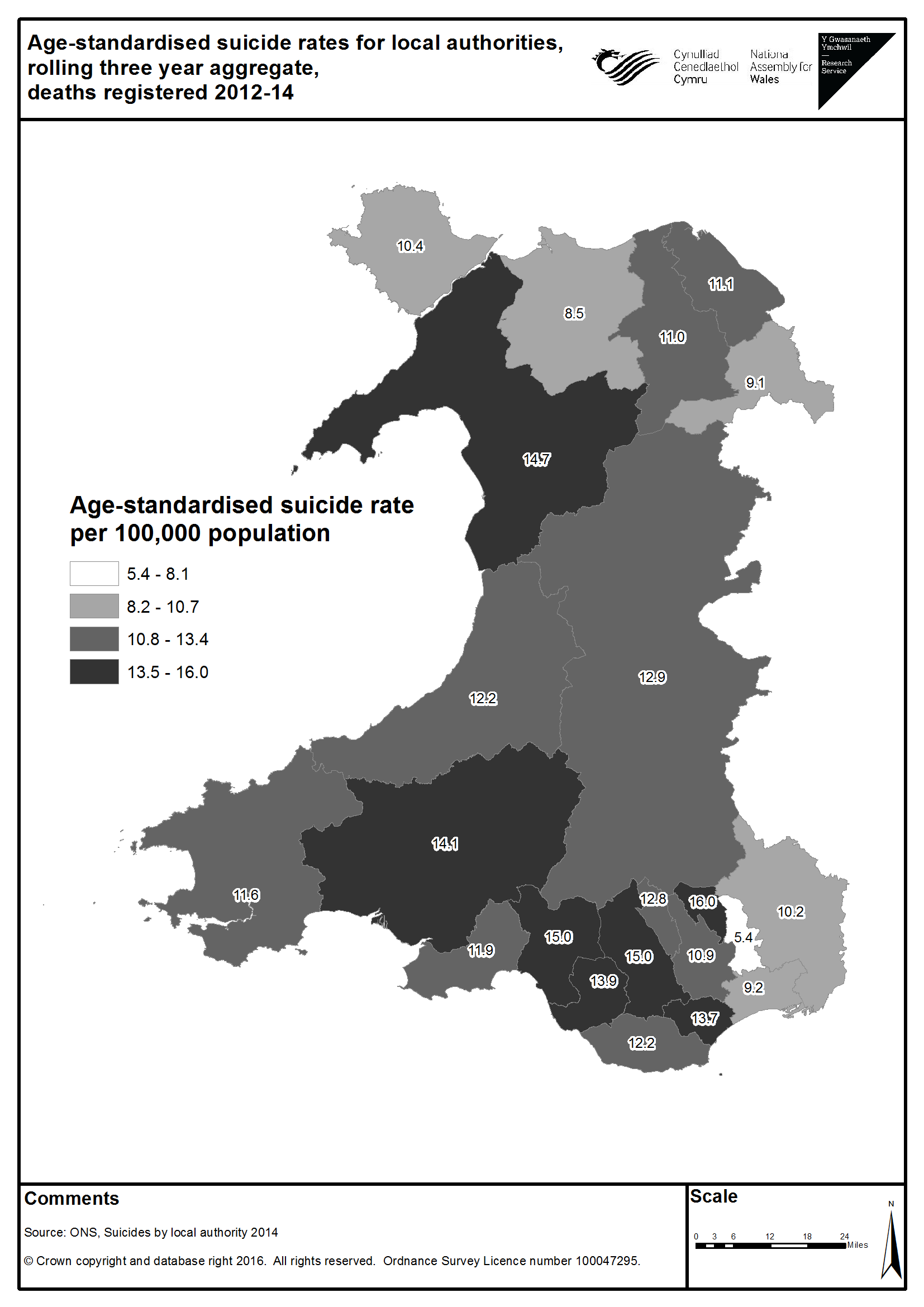Article by Helen Jones and Paul Worthington, National Assembly for Wales Research Service
Ahead of the Members debate regarding suicide on 9 March this blog article looks at the most recent statistics and the latest Welsh Government strategy for preventing suicide in Wales. The latest statistics on suicide were published by the Office for National Statistics (ONS) on 4 February 2016, Suicides in the United Kingdom: 2014 registrations. The data are presented as age-standardised suicide rates per 100,000 population. This technique is used to allow comparisons of populations with different age profiles. The 2014 data shows that Wales has the lowest age-standardised suicide rate of the UK nations, 9.2 deaths per 100,000 population. Table 1: Age-standardised suicide rates per 100,000 population, 2014  Source: ONS, Suicides in the United Kingdom, 2014 Comparable data for the UK nations is available from 1981 to 2014. The graph below shows the age-standardised suicide rate for Wales has ranged between 9 and 15 deaths per 100,000 population in this period. In Wales the highest rate was in 1982 (14.9) and the lowest rate was in 2014 (9.2). Figure 1: Age standardised suicide rates per 100,000 population, 1981 to 2014
Source: ONS, Suicides in the United Kingdom, 2014 Comparable data for the UK nations is available from 1981 to 2014. The graph below shows the age-standardised suicide rate for Wales has ranged between 9 and 15 deaths per 100,000 population in this period. In Wales the highest rate was in 1982 (14.9) and the lowest rate was in 2014 (9.2). Figure 1: Age standardised suicide rates per 100,000 population, 1981 to 2014  Source: ONS, Suicides in the United Kingdom, 2014 Sex The 2014 data shows the male age-standardised suicide rates are consistently higher than the female rates. In Wales in 2014 the male rate was 15.3 deaths per 100,000 population compared to 3.4 female deaths per 100,000 population. Public Health Wales (PHW) suggest this higher rate may be because men tend to use different methods to those used by women. Women are much more likely than men to be admitted to hospital as a result of self harm. During 2007/08, a spate of suicides in the Welsh town of Bridgend attracted considerable local and national attention, although the reasons for this concentrated high level of suicides amongst young people in the town remain unclear. Indeed, PHW report there is no single reason why someone may try to take their own life and it is best understood by looking at each person’s life and circumstances. However certain factors or problems may increase the risk of suicide, including social isolation or stressful life events and mental health problems. Age Age-specific suicide rates for Wales are also available in five year age bands. The graph below reveals the age groups 40-44, 85-90 and 55-59 had the highest suicide rates in Wales. The age groups 20-24 and 75-79 had the lowest suicide rates. Figure 2: Age-specific suicide rates per 100,000 population in Wales by five-year age group, 2014
Source: ONS, Suicides in the United Kingdom, 2014 Sex The 2014 data shows the male age-standardised suicide rates are consistently higher than the female rates. In Wales in 2014 the male rate was 15.3 deaths per 100,000 population compared to 3.4 female deaths per 100,000 population. Public Health Wales (PHW) suggest this higher rate may be because men tend to use different methods to those used by women. Women are much more likely than men to be admitted to hospital as a result of self harm. During 2007/08, a spate of suicides in the Welsh town of Bridgend attracted considerable local and national attention, although the reasons for this concentrated high level of suicides amongst young people in the town remain unclear. Indeed, PHW report there is no single reason why someone may try to take their own life and it is best understood by looking at each person’s life and circumstances. However certain factors or problems may increase the risk of suicide, including social isolation or stressful life events and mental health problems. Age Age-specific suicide rates for Wales are also available in five year age bands. The graph below reveals the age groups 40-44, 85-90 and 55-59 had the highest suicide rates in Wales. The age groups 20-24 and 75-79 had the lowest suicide rates. Figure 2: Age-specific suicide rates per 100,000 population in Wales by five-year age group, 2014  Source: ONS, Suicides in the United Kingdom, 2014 Data is available at a male and female level for the five year age groups, however due to the small number of female suicides in Wales the age-specific rates are only reliable for males. The data shows males aged 40-44 had the highest suicide rate, 29.1 deaths per 100,000. By local authority The map below shows that Blaenau Gwent had the highest suicide rate, 16 deaths per 100,000 population. Torfaen had the lowest suicide rate with 5.4 deaths per 100,000 population in 2014.
Source: ONS, Suicides in the United Kingdom, 2014 Data is available at a male and female level for the five year age groups, however due to the small number of female suicides in Wales the age-specific rates are only reliable for males. The data shows males aged 40-44 had the highest suicide rate, 29.1 deaths per 100,000. By local authority The map below shows that Blaenau Gwent had the highest suicide rate, 16 deaths per 100,000 population. Torfaen had the lowest suicide rate with 5.4 deaths per 100,000 population in 2014. Source: ONS, Suicides by local authority, 2014 Strategies for reducing and preventing suicide in Wales In July 2015 the Health and Social Services Minister launched Talk to Me 2, a 5 year plan aimed at reducing suicide and self harm by identifying those groups of people particularly vulnerable to suicide and self harm and setting out the care they should receive. The Strategy sets out a number of priority actions designed to achieve this:
Source: ONS, Suicides by local authority, 2014 Strategies for reducing and preventing suicide in Wales In July 2015 the Health and Social Services Minister launched Talk to Me 2, a 5 year plan aimed at reducing suicide and self harm by identifying those groups of people particularly vulnerable to suicide and self harm and setting out the care they should receive. The Strategy sets out a number of priority actions designed to achieve this:
- Delivering appropriate responses to personal crises, early intervention and management of suicide and self harm
- Further improving awareness, knowledge and understanding of suicide and self harm among the public; people who frequently come into contact with those at risk of suicide and self harm and professionals in Wales
- Providing information and support for people bereaved or affected by suicide and self harm
- Supporting the media in the responsible reporting and portrayal of suicide and suicidal behaviour
- Reducing access to the means of suicide
- Continuing to promote and support learning, information and monitoring systems and research to improve understanding of suicide and self harm in Wales.
The Strategy also recognises the need for improved data in some areas relating to suicide and self-harm. Organisations such as MIND Cymru argue for the value of encouraging people to be open about their feelings, to ask for help, and to be able to access the right help and support at the right time; they also provide contacts for some services. At the same time, there is recognition that services need to reflect the specific needs of different groups and focus support accordingly. For example, Merseyside CALMzone specifically targets men aged 15-54 across Merseyside, Warrington and Cheshire East, supporting their wellbeing.






